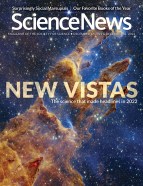Readers ask about sea level rise, the universe’s first stars and more
- More than 2 years ago

On the rise
A thinning, accelerating ice stream in Greenland’s interior could contribute nearly 16 millimeters to global sea level rise by 2100, more than six times as much as previously thought, Nikk Ogasa reported in “Greenland is hemorrhaging ice” (SN: 12/17/22 & 12/31/22, p. 7).
Reader Leslie Hruby wondered how local sea levels will be affected as an ice sheet melts and the land underneath rebounds.
“The immense weight of the ice can depress the Earth’s crust, just like a heavy object placed on a soft mattress,” Ogasa says. When the ice retreats, the unburdened ground rises back up. What’s more, as the ice loses mass, its gravitational pull on the nearby ocean also wanes. When polar ice retreats, these changes can compound to lower the local sea level but raise the sea level farther off. “Projections indicate that sea level rise will be most severe along the coastal areas farthest from the polar regions, such as South and Southeast Asia,” Ogasa says. “These regions are home to large, low-income populations who bear the least responsibility for climate change, but they will face the worst of it.”
Keeping ethics in mind
In the lab, brain implants can translate internal speech into external signals, technology that could help people who are unable to speak or type, Laura Sanders reported in “Brain implants ‘read’ thoughts” (SN: 12/17/22 & 12/31/22, p. 8).
Reader J Morley rejoiced that the technology might one day help people but worried about what it means for privacy.
Morley raises a common concern. In 2020, Science News asked readers about their views on brain technology that can read — and perhaps influence — brain activity. Concerns about privacy rose to the top of the list (SN: 2/13/21, p. 24).
Sanders says many of the scientists she spoke to in her reporting emphasized the flip side. “They feel a moral imperative to move research forward so that they can help people by restoring the ability to communicate, for instance, or relieving symptoms of a distressing mental illness,” she says. “It’s a complex area that defies simple black-and-white thinking; there is room here for lots of different perspectives and priorities.”
Back to life
A species of clam called Cymatioa cooki (shown below) that scientists thought had been extinct for about 30,000 years was found alive off the coast of California, Allison Gasparini reported in “Clam discovery resurrects a long-dead species” (SN: 12/17/22 & 12/31/22, p. 4). “This is what I love about science,” Facebook user Debra Chugg wrote. “There’s always the ‘unexpected’ out there that can rewrite our learning. [Every day], there’s the possibility of yet another wonderful discovery.”

Just wondering
Science News readers often ask questions that are unrelated to our journalism but are fascinating nonetheless. We’re indulging our nerdy impulses to try to answer those questions.
Reader Steve Ostrom asked if the James Webb Space Telescope needs to be pointed in a particular direction to look for the first generation of stars after the Big Bang.
“To get a glimpse of the first stars, JWST needs a clear view beyond our galaxy, so it must not be pointed at the Milky Way’s center or at any impenetrable walls of dust in our galaxy,” says associate news editor Christopher Crockett, who has a Ph.D. in astronomy. “But the direction itself doesn’t matter.”
This is because the Big Bang happened everywhere all at once, Crockett says. “It is less of a place in space and more of an event imprinted everywhere if we look far enough out.”
Think of it this way: Roughly 13 billion years ago, a first generation of stars was coming to life all around Earth’s current location in space. Back then, if someone stood where we are now, they might have seen brand-new stars forming in all directions. Fast forward to the present, and it’s kind of the same idea, Crockett says. Look in one direction with JWST, and you might see a bunch of first- generation stars that were once relatively close to Earth’s current location. Turn the telescope around, and you might see another bunch of first-gen stars.
That doesn’t mean that the first stars were born everywhere at the exact same moment, Crockett says. The first stars were born over millions of years due to local variations in things like the density and temperature of hydrogen clouds. It was “an epoch when conditions throughout the universe were finally right to allow hydrogen clouds to collapse and ignite fusion for the first time.”
Send your science questions to feedback@sciencenews.org.